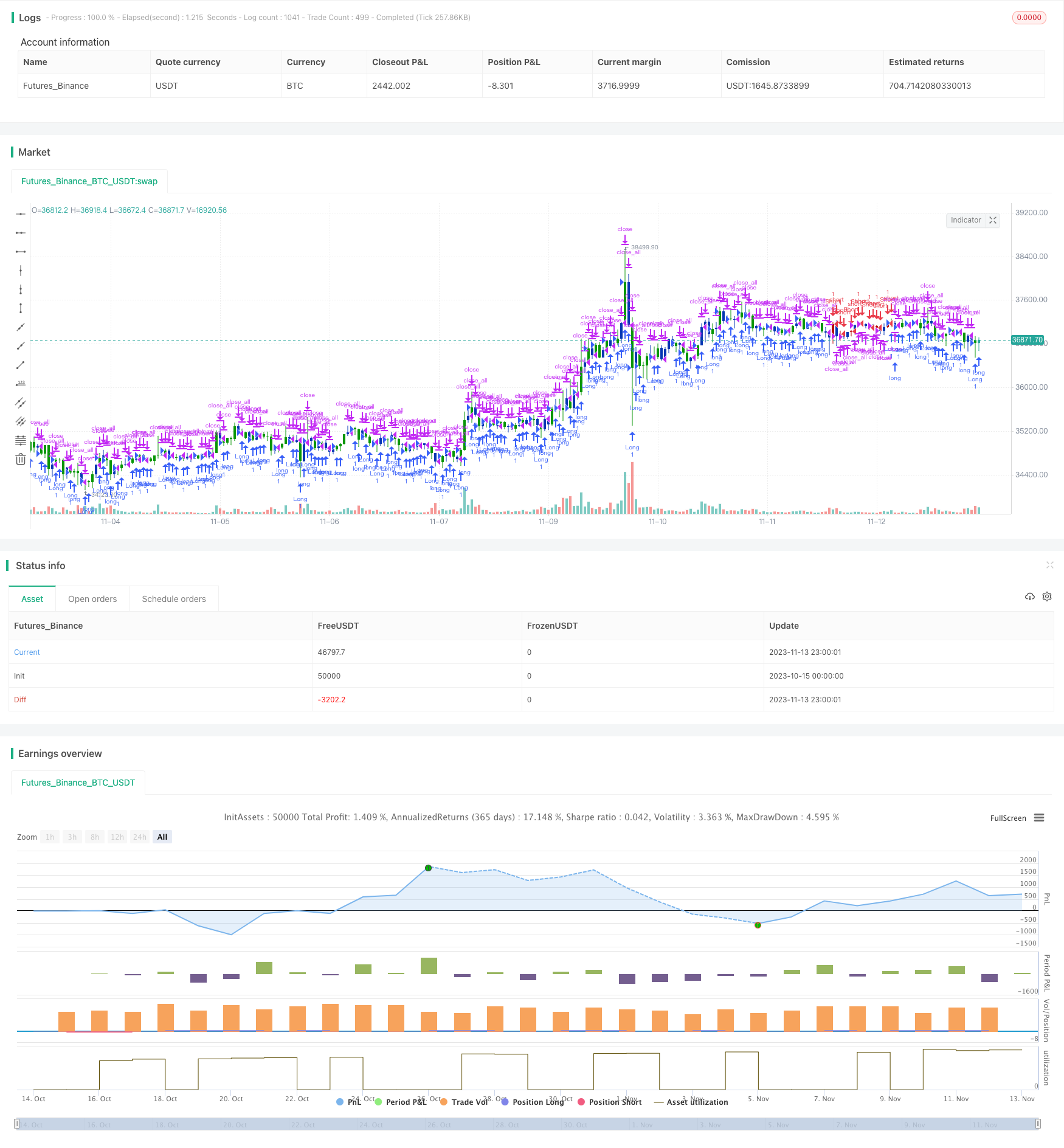
概述
该策略结合了123形态反转和易于移动两种策略,目的是通过捕捉价格的转折点来进行交易。123形态反转策略在股票价格连续三日形成特定模型时产生信号。易于移动(EOM)策略则利用价格和交易量变化判断市场动量。这两种策略相结合,既考虑了价格的技术形态,也考虑了市场动量,从而提高交易信号的准确性。
策略原理
该策略由两部分组成:
123形态反转策略
- 使用Stoch指标判断超买超卖
- 当收盘价连续两日下跌,且Stoch快线高于慢线时做空
- 当收盘价连续两日上涨,且Stoch快线低于慢线时做多
易于移动策略
- 计算前一日的区间中点
- 计算区间中点相对于前一日的移动(变化)
- 计算区间中点移动和成交量的比值
- 比值大于阈值时看涨,小于阈值时看跌
综合两个信号,当Easy of Movement和123形态同时做多信号时,开多仓;当Easy of Movement和123形态同时做空信号时,开空仓。
优势分析
该策略具有以下优势:
结合价格技术形态和市场动量,提高信号准确性
123形态反转捕捉转折点,易于移动判断趋势动量,二者互补
Stoch指标避免在盘整中反复开平仓
交易逻辑简单清晰,容易实施
可自定义参数,适应不同市场环境
风险分析
该策略也存在一些风险:
过于依赖参数设置,参数不当可能导致交易频繁或漏单
多种过滤条件联合使用,信号产生频率可能过低
易于移动指标对市场波动敏感,可引发假信号
实盘略逊回测,需要控制仓位规模
仅适用趋势性股票,不适合盘整市
优化方向
可以从以下几方面优化该策略:
优化参数,调整过滤条件严格程度,平衡交易频率和信号质量
加入止损策略,严格控制单笔损失
结合趋势过滤,避免逆势交易
增加资金管理模块,根据波动率动态调整仓位
采用机器学习方法优化参数,使之动态适应市场
总结
该策略整合价格技术指标和市场动量指标,在捕捉转折点的同时确认趋势质量,具有较高的实战价值。但也需要注意控制交易频率、单笔损失和逆势操作的风险。通过参数优化、止损策略、趋势过滤等手段可以进一步提升策略的稳定性和盈利能力。该策略思路清晰易于实施,值得量化交易者继续研究和改进。
策略源码
/*backtest
start: 2023-10-15 00:00:00
end: 2023-11-14 00:00:00
period: 1h
basePeriod: 15m
exchanges: [{"eid":"Futures_Binance","currency":"BTC_USDT"}]
*/
//@version=4
////////////////////////////////////////////////////////////
// Copyright by HPotter v1.0 14/04/2020
// This is combo strategies for get a cumulative signal.
//
// First strategy
// This System was created from the Book "How I Tripled My Money In The
// Futures Market" by Ulf Jensen, Page 183. This is reverse type of strategies.
// The strategy buys at market, if close price is higher than the previous close
// during 2 days and the meaning of 9-days Stochastic Slow Oscillator is lower than 50.
// The strategy sells at market, if close price is lower than the previous close price
// during 2 days and the meaning of 9-days Stochastic Fast Oscillator is higher than 50.
//
// Second strategy
// This indicator gauges the magnitude of price and volume movement.
// The indicator returns both positive and negative values where a
// positive value means the market has moved up from yesterday's value
// and a negative value means the market has moved down. A large positive
// or large negative value indicates a large move in price and/or lighter
// volume. A small positive or small negative value indicates a small move
// in price and/or heavier volume.
// A positive or negative numeric value. A positive value means the market
// has moved up from yesterday's value, whereas, a negative value means the
// market has moved down.
//
// WARNING:
// - For purpose educate only
// - This script to change bars colors.
////////////////////////////////////////////////////////////
Reversal123(Length, KSmoothing, DLength, Level) =>
vFast = sma(stoch(close, high, low, Length), KSmoothing)
vSlow = sma(vFast, DLength)
pos = 0.0
pos := iff(close[2] < close[1] and close > close[1] and vFast < vSlow and vFast > Level, 1,
iff(close[2] > close[1] and close < close[1] and vFast > vSlow and vFast < Level, -1, nz(pos[1], 0)))
pos
EOM(BuyZone, SellZone) =>
pos = 0
xHigh = high
xLow = low
xVolume = volume
xHalfRange = (xHigh - xLow) * 0.5
xMidpointMove = mom(xHalfRange, 1)
xBoxRatio = iff((xHigh - xLow) != 0, xVolume / (xHigh - xLow), 0)
nRes = iff(xBoxRatio != 0, 1000000 * ((xMidpointMove - xMidpointMove[1]) / xBoxRatio), 0)
pos := iff(nRes > BuyZone, 1,
iff(nRes < SellZone, -1, nz(pos[1], 0)))
pos
strategy(title="Combo Backtest 123 Reversal & Ease of Movement (EOM)", shorttitle="Combo", overlay = true)
Length = input(14, minval=1)
KSmoothing = input(1, minval=1)
DLength = input(3, minval=1)
Level = input(50, minval=1)
//-------------------------
BuyZone = input(4000, minval=1)
SellZone = input(-4000)
reverse = input(false, title="Trade reverse")
posReversal123 = Reversal123(Length, KSmoothing, DLength, Level)
posEOM = EOM(BuyZone, SellZone)
pos = iff(posReversal123 == 1 and posEOM == 1 , 1,
iff(posReversal123 == -1 and posEOM == -1, -1, 0))
possig = iff(reverse and pos == 1, -1,
iff(reverse and pos == -1 , 1, pos))
if (possig == 1)
strategy.entry("Long", strategy.long)
if (possig == -1)
strategy.entry("Short", strategy.short)
if (possig == 0)
strategy.close_all()
barcolor(possig == -1 ? #b50404: possig == 1 ? #079605 : #0536b3 )